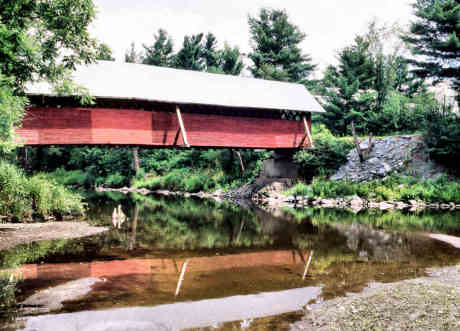
School House Bridge - 1910
from Spanning Time: Vermont's Covered Bridges¹

North Troy, 1997 - Barn red, the ninety-two-foot School House Bridge stands at a bend in the Missisquoi River, next to a ford and a sandbar. At low water, a viewer can walk out on the bar to within a hundred feet of the span.
The bridge is of special interest because of the three pairs of "flying buttresses" and because of the low roof line. The height of the plank-lattice trusses on this bridge are only nine feet eight inches, one to two feet shorter than usual, leaving insufficient space for getting haywagons through if the conventional interior bracing system had been used. The external buttresses provide the required lateral bracing to resist wind forces and to keep the bridge trusses square and straight.
The trusses are of comparatively light construction. The lattice planks measure two-inches by nine-inches versus the usual three-inches by ten or eleven inches, and the web crossings are pinned by one treenail where normally two are used. Further, three sets of chords strengthen the span rather than the usual four, as the upper secondary chords are missing. The chords also consist of only one plank on each side of the webbing instead of the usual two. On the positive side, the chord planks are twice the thickness of those used in other plank lattice bridges, measuring at least six inches. Where other lattice-bridge chords use two planks on each side of the web, staggered and pinned to gain length, the chords in the School House Bridge are joined end to end using a peculiar "E" shaped splice block secured with bolts. Also on the positive side, the web spacing is on twenty-nine-inch centers instead of the customary thirty-six-inch center.
Using just one treenail at the web intersections "may be a weakness," said an Agency of Transportation inspection report, "since some compression lattice members are buckling away from the tension members with gaps developing between the two".
The Vermont Division of Historic Sites used a bridge build date of 1910 in the application for inclusion of the bridge on the National Register of Historic Places. The name of the builder is unknown.
According to the research of Richard Sanders Allen, there were formerly three similar single-pin buttressed bridges in the towns of Troy and Westfield. Phil Ziegler, in his Sentinels of Time, Vermont's Covered Bridges, tells us that the School House Bridge collapsed in 1958 and was later rebuilt. The bridge also survived a fire, date unknown. The structure shows signs of the sandblasting done to remove the char. Gilbert Newbury claims that some of the fire scars can still be seen.

Photo by Joe Nelson, 1997
Also known as River Road Bridge, Troy Bridge, and Upper Bridge.
1. Spanning Time Vermont's Covered Bridges by Joseph C. Nelson ©1997
